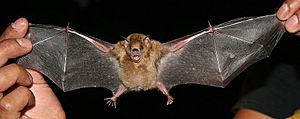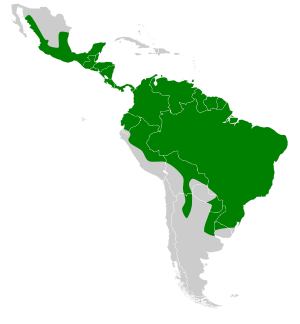Little yellow-shouldered bat facts for kids
Quick facts for kids Little yellow-shouldered bat |
|
|---|---|
 |
|
| Conservation status | |
| Scientific classification | |
| Genus: |
Sturnira
|
| Species: |
lilium
|
 |
|
The little yellow-shouldered bat (Sturnira lilium) is a fascinating bat species found in South and Central America. These bats are known for their special diet, as they are frugivores, meaning they mostly eat fruit. This makes them very important for nature because they help spread seeds, acting as effective seed dispersers.
These small bats usually live alone. They find safe places to rest during the day, called roosts. They might roost in tree cavities, on branches, hanging from vines, or even under large palm leaves. What's interesting is that they often return to the same roosting spots day after day.
How They Stay Warm and Save Energy
Little yellow-shouldered bats have a clever way to save energy, especially when it's cooler or food is scarce. They can use a strategy called hypothermia. This means their body temperature can drop lower than usual. By doing this, their bodies slow down, which helps them save energy and adjust their metabolism. It's like taking a power nap to conserve fuel!
Scientists have also noticed that the temperature around them plays a bigger role in when they mate than how much food is available. This shows how much these bats rely on their environment.
Flight and Reproduction
Even a bat's body shape can change for important reasons! When a female little yellow-shouldered bat is pregnant, her wing shape can actually change slightly. This change helps her fly more efficiently, making it easier to carry her developing baby. This is a great example of how animals adapt to their life stages to survive and thrive.
Gallery
See also
 In Spanish: Sturnira lilium para niños
In Spanish: Sturnira lilium para niños




